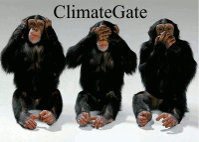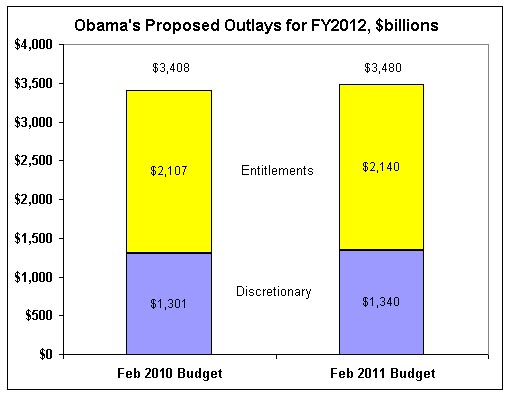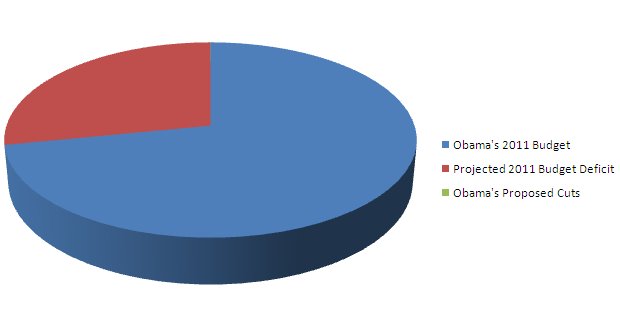05-14-2011

Permalink


Growth Of The
National Debt
|
Subject: Balancing The Federal Budget: A Simple Proposal
Take a look at the following chart:
 See any possible problems there? From 1940 and for thirty years
thereafter, although the the national debt was increasing, it did
so at a fairly slow rate. However, by the 1970s the rate of increase
starts to accelerate as indicated by the steepening curve, until the
rate begins to go asymptotic around 2007, indicating that the the
factors controlling the debt have gotten completely out of control.
Now, examing the annual level of federal spending in constant,
inflation-adjusted dollars.
See any possible problems there? From 1940 and for thirty years
thereafter, although the the national debt was increasing, it did
so at a fairly slow rate. However, by the 1970s the rate of increase
starts to accelerate as indicated by the steepening curve, until the
rate begins to go asymptotic around 2007, indicating that the the
factors controlling the debt have gotten completely out of control.
Now, examing the annual level of federal spending in constant,
inflation-adjusted dollars.
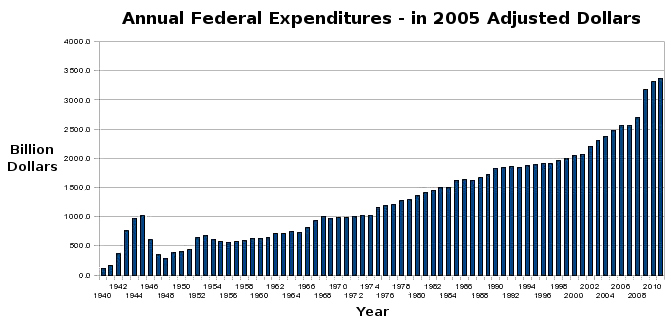 Here we see a fairly constant year-after-year increase in federal
spending, indicating the steady growth in the overall size of
government. Let's break this down by decade.
Here we see a fairly constant year-after-year increase in federal
spending, indicating the steady growth in the overall size of
government. Let's break this down by decade.
|
Decade
|
Average Annual Spending
in Constant 2005 Dollars
(Billions)
|
Spending Increase
From Previous Decade
(Percent)
|
Ratio of 2011
Govmt. Spending
to Decade Average
|
|
1940s
|
$502.4
|
–
|
7.6x
|
|
1950s
|
$569.7
|
13.4%
|
6.7x
|
|
1960s
|
$788.4
|
38.4%
|
4.8x
|
|
1970s
|
$1,115.2
|
41.5%
|
3.4x
|
|
1980s
|
$1,549.9
|
40.0%
|
2.5x
|
|
1990s
|
$1,893.1
|
22.1%
|
2.0x
|
|
2000s*
|
$2,597.6
|
37.2%
|
1.5x
|
* 12 year average: 2000-2011
Even if we assume that the 2011 expenditures is an anomaly and consider
decade averages only, these figures show that government size in the
2000s is over five times larger than it was during the 1940s.
And if we average the expenditures for the thirty year period from
1940-1969, our current federal government has still increased more than
four times over that historical level.
Now, let's take a look at the revenue side of the picture.
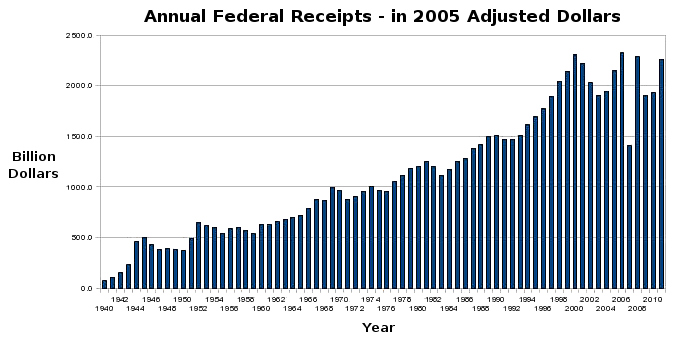 As with expenditures, we observe a steady increase in revenue, every
penny of which comes from American citizens, either directly or
indirectly. Breaking this data down by decade reveals the following:
As with expenditures, we observe a steady increase in revenue, every
penny of which comes from American citizens, either directly or
indirectly. Breaking this data down by decade reveals the following:
|
Decade
|
Average Annual Revenues
in Constant 2005 Dollars
(Billions)
|
Revenue Increase
From Previous Decade
(Percent)
|
Ratio of 2011
Govmt. Revenue
to Decade Average
|
|
1940s
|
$313.2
|
–
|
6.9x
|
|
1950s
|
$556.5
|
77.7%
|
3.9x
|
|
1960s
|
$754.2
|
35.5%
|
2.9x
|
|
1970s
|
$999.3
|
32.5%
|
2.2x
|
|
1980s
|
$1,275.9
|
27.7%
|
1.7x
|
|
1990s
|
$1,711.3
|
34.1%
|
1.3x
|
|
2000s*
|
$2,139.4
|
25.0%
|
1.0x
|
* 12 year average: 2000-2011
Note the steady and very substantial decade-after-decade increase
in the amount of wealth extracted from productive individuals and
businesses. Examining just the period from 2000-2011, the total
revenue (in 2005 dollars) was $25.7 trillion. If government spending
had been held to the 1980s average of $1.55 trillion/year for a
total expenditure of $18.6 trillion over the same 12 year period,
then there would have been a net surplus of $7.1 trillion,
which would have allowed for the complete elimination of the $5.6
trillion debt that existed in 2000, with a $1.5 trillion cushion
remaining.
Stop and think about that. With a steadily increasing revenue stream
that not only could meet all existing expenses, but would have allowed
the entire national debt to be retired in just over a decade, what
happened? And how instead, did the debt almost triple in such a short
period of time?
This chart tells the story:
 The national debt continues to rise, because, no matter how much
revenue is at their disposal, and no matter how significantly it
increases, the Congress and the President work diligently to spend
every available nickel, and then go into debt in order to spend
even more — lots more! As this chart shows, the government
has run a deficit 28 out of the last 32 years, or 88% of the
time.
And a review of the historical
data reveals that since 1940, there have been deficits 60 out of
the past 72 years!
During that 72 year period, while both the Republican and the
Democratic parties have held the presidency in equal measure (36 years
each), together, they have managed to balance the budget less than 17%
of the time (five times under Republicans and seven times under
Democrats). And of those 12 budget surpluses, only six were used to
slightly reduce the debt, the last time being 42 years ago in 1969.
During the past seven decades, the current $14.3 trillion debt
has been ratcheted back by just $25.5 billion, or less than 0.2% of
the current total!
For 2011, our $3.82
trillion budget
includes an estimated $1.65
trillion deficit, which pushes total federal debt well
beyond the current $14.3
trillion spending cap. At currently projected spending levels,
the debt is estimated to be rapidly approaching
$20 trillion
by 2015.
In 2010 alone, the United States paid $414 billion simply to
finance the debt burden. And since 2000, interest payments exceed
$4.4
trillion. That is money that has been removed from productive
use by individuals and businesses in the U.S. economy and sent
primarily to foreign
creditors, including: China, Japan, UK, Brazil, Taiwan, Russia, and
so on.
While a number of intellectuals in the political and financial spheres
have, for many years, been sounding alarm bells about the pending
disaster being created by a ballooning debt, rising interest payments,
and the unfunded
liabilities resulting from Social Security, Medicare and Medicaid,
it wasn't until early in 2009 that a large segment of the general
public awoke to the imminent economic danger presented by unsustainable
government expansion, coupled with the the rise of a totalitarian
political class, leveraging America's cultural shift away from
self-reliance and personal responsibility and towards a helpless
entitlement mentality. The rise of the Tea Party movement was the
political response to these new realizations.
In the 2010 elections, the clear message sent was that past political
behavior was no longer going to be tolerated by the public. The budget
was to be balanced, the debt paid down, earmarks eliminated, taxes
reduced, federal spending slashed, and the size and regulatory burden
of government was to be significantly decreased. In general, Democrats
ignored this outcry and were resoundingly defeated by Republicans who
at least paid lip service to these demands. However, after returning
to D.C. following the elections, the overall performance by the new
congressional members has been extremely disappointing. Republicans
who once spoke of slashing spending, balancing the budget, repealing
Obamacare, significantly reducing the size of government, and
returning to a rule of law in strictly proscribed areas, as dictated
by the Constitution, have failed to even take a firm stand on these
issues, let alone deliver meaningful results on their promises.
For example, prior to the 2011 budget negotiations, Republicans promised
a rather anemic $100 billion (2.6%) reduction against Obama's huge
$3.82 trillion budget and $1.65 trillion deficit. However, by the
time the budget was finalized in April, they had capitulated to a
mere $38.5 billion (1%) reduction, which then turned out to actually
be a true savings of only $352
million (0.01%), leaving the Democrats laughing all the way to
the printing presses.
The national debt continues to rise, because, no matter how much
revenue is at their disposal, and no matter how significantly it
increases, the Congress and the President work diligently to spend
every available nickel, and then go into debt in order to spend
even more — lots more! As this chart shows, the government
has run a deficit 28 out of the last 32 years, or 88% of the
time.
And a review of the historical
data reveals that since 1940, there have been deficits 60 out of
the past 72 years!
During that 72 year period, while both the Republican and the
Democratic parties have held the presidency in equal measure (36 years
each), together, they have managed to balance the budget less than 17%
of the time (five times under Republicans and seven times under
Democrats). And of those 12 budget surpluses, only six were used to
slightly reduce the debt, the last time being 42 years ago in 1969.
During the past seven decades, the current $14.3 trillion debt
has been ratcheted back by just $25.5 billion, or less than 0.2% of
the current total!
For 2011, our $3.82
trillion budget
includes an estimated $1.65
trillion deficit, which pushes total federal debt well
beyond the current $14.3
trillion spending cap. At currently projected spending levels,
the debt is estimated to be rapidly approaching
$20 trillion
by 2015.
In 2010 alone, the United States paid $414 billion simply to
finance the debt burden. And since 2000, interest payments exceed
$4.4
trillion. That is money that has been removed from productive
use by individuals and businesses in the U.S. economy and sent
primarily to foreign
creditors, including: China, Japan, UK, Brazil, Taiwan, Russia, and
so on.
While a number of intellectuals in the political and financial spheres
have, for many years, been sounding alarm bells about the pending
disaster being created by a ballooning debt, rising interest payments,
and the unfunded
liabilities resulting from Social Security, Medicare and Medicaid,
it wasn't until early in 2009 that a large segment of the general
public awoke to the imminent economic danger presented by unsustainable
government expansion, coupled with the the rise of a totalitarian
political class, leveraging America's cultural shift away from
self-reliance and personal responsibility and towards a helpless
entitlement mentality. The rise of the Tea Party movement was the
political response to these new realizations.
In the 2010 elections, the clear message sent was that past political
behavior was no longer going to be tolerated by the public. The budget
was to be balanced, the debt paid down, earmarks eliminated, taxes
reduced, federal spending slashed, and the size and regulatory burden
of government was to be significantly decreased. In general, Democrats
ignored this outcry and were resoundingly defeated by Republicans who
at least paid lip service to these demands. However, after returning
to D.C. following the elections, the overall performance by the new
congressional members has been extremely disappointing. Republicans
who once spoke of slashing spending, balancing the budget, repealing
Obamacare, significantly reducing the size of government, and
returning to a rule of law in strictly proscribed areas, as dictated
by the Constitution, have failed to even take a firm stand on these
issues, let alone deliver meaningful results on their promises.
For example, prior to the 2011 budget negotiations, Republicans promised
a rather anemic $100 billion (2.6%) reduction against Obama's huge
$3.82 trillion budget and $1.65 trillion deficit. However, by the
time the budget was finalized in April, they had capitulated to a
mere $38.5 billion (1%) reduction, which then turned out to actually
be a true savings of only $352
million (0.01%), leaving the Democrats laughing all the way to
the printing presses.
 Or consider Paul Ryan's much touted "Path to Prosperity", which
the Republicans offer as their alternative for addressing entitlement
liabilities while cutting spending by $6.2 trillion over the next 10
years. Well that sounds pretty good until you look a bit closer. Did
you think that current spending levels were going to be reduced by
$6.2 trillion? Well fuggedaboutit. This is just the Republicans using
the standard political trick of misdirection, as the following chart
reveals:
Or consider Paul Ryan's much touted "Path to Prosperity", which
the Republicans offer as their alternative for addressing entitlement
liabilities while cutting spending by $6.2 trillion over the next 10
years. Well that sounds pretty good until you look a bit closer. Did
you think that current spending levels were going to be reduced by
$6.2 trillion? Well fuggedaboutit. This is just the Republicans using
the standard political trick of misdirection, as the following chart
reveals:
 Ryan's plan has no intention of balancing the budget in the foreseeable
future. He has government spending increasing year by year, just not
quite as fast as Obama's own proposal. His $6.2 trillion is not a
real savings, but just some imaginary gap between his fantasy
projection for the future and that of the current administration, both
of which are unrealistic because, as with almost every past budget,
they significantly overestimate future revenue while underestimating
future outlays, giving us an 88% change of continuing deficits and an
ever growing debt.
It is all a form of political theater and wish fulfillment that runs
through every thread of government, best illustrated by the recently
released Changes
in CBO's Baseline Projections Since January 2001, which reports:
Ryan's plan has no intention of balancing the budget in the foreseeable
future. He has government spending increasing year by year, just not
quite as fast as Obama's own proposal. His $6.2 trillion is not a
real savings, but just some imaginary gap between his fantasy
projection for the future and that of the current administration, both
of which are unrealistic because, as with almost every past budget,
they significantly overestimate future revenue while underestimating
future outlays, giving us an 88% change of continuing deficits and an
ever growing debt.
It is all a form of political theater and wish fulfillment that runs
through every thread of government, best illustrated by the recently
released Changes
in CBO's Baseline Projections Since January 2001, which reports:
|
Each year, the Congressional Budget Office (CBO) issues
baseline projections of federal spending and revenues for the
following 10 years. Those projections are not intended as a
forecast of future outcomes; rather, they are estimates of
spending and revenues under the laws that are in effect at
that time and are designed to provide a benchmark against which
to measure future policy changes.
In January 2001, CBO's baseline projections showed a cumulative
surplus of $5.6 trillion for the 2002-2011 period. The actual
results have differed from those projections because of
subsequent policy changes, economic developments that differed
from CBO's forecast, and other factors. As a result, the
federal government actually ran deficits from 2002 through 2010
and will incur a deficit in 2011 as well. The cumulative
deficit over the 10-year period will amount to $6.2 trillion,
CBO estimates—a swing of $11.8 trillion from the January
2001 projections.
|
How many times do you think the CBO has been off $11.8 trillion
dollars in the other direction?
My simple (and unrealistic) proposal:
Having observer the new Congress unsuccessfully tackle issues such
as the 2011 budget, it seems clear that, as things stand, nothing of
real substance can be expected to be accomplished. So long as Congress
retains the ability to both set the level of spending as well as
determine where that spending is to be allocated, there remains little
hope that they will ever exercise any real fiscal restraint and make
the difficult choices that are required. And we taxpayers are the ones
left on the hook for the tab they continue to accumulate.
The unrealistic part of my proposal — something that would
require a change to the Constitution — is that the ability
to set the overall annual spending level must be removed from the
hands of government completely. In the long run, there are a number
of ways that these levels could be determined, but I believe that
the best would be to simply establish some very reasonable but fixed
dollar amount that would be the sum total available for all normal
government operations, with a provision for automatic adjustment
to account for inflation/deflation. This would then be coupled with
a balanced budget amendment that would require that the government
maintain its spending strictly within this limit. Emergency
situations such as declared wars, would be precisely defined, and
funding for these activities would be handled by other means, but
the overall size and nominal cost of government functions would be
strictly proscribed and fully understood by all citizens.
Given a known annual budget, it would then be up to Congress to
determine how to allocate these dollars. They could fund government
payroll, pensions and insurance. They would be responsible for
facility rent, new construction and maintenance. They would apportion
funds between agencies such as the CIA, FBI, the Armed Services and
others. They could fund entitlement programs, or promote initiatives
like cash-for-clunkers or home window replacement for energy
conservation. They could send aid to foreign countries, support the
UN or invest in promising new technologies. Money could be spent on
pure research or used to build and launch rockets. Some funds might
go to help the poor obtain health insurance or purchase prescription
drugs, while others could be used to build bridges to nowhere or
monuments to past presidents or fight the "war" on drugs. The sky's
the limit. The only condition would be that should they wish to
allocate some funds to one area, for example, to set up a presidential
cell phone emergency alert system, then these dollars would have to
come from or at the expense of something else. Citizens would elect
representatives that promised to promote things of agreed importance,
and then it would be up to those representatives to work with other
congressional member to devise the best allocation strategy —
just an families and businesses routinely do every day as a matter of
course. One huge consequence of this approach is that it would very
quickly be determined what the real priorities were for all of the
possible expenditures. It would soon become evident how entitlements
for the needy weighed in relation to immigration reform, illegal drug
use, energy policy, and so on.
To implement this plan would also require addressing the problem of
getting from here to there. Right now our deficit is $1.65 trillion
in relation to a budget of $3.82 trillion, making the deficit a
whopping 43% of the total! My proposal would be to immediately
start cutting the existing budget across the board by 10%, or $382
billion for each of the next five years: 2012-2016. By declaring that
these cuts apply equally to all areas of government — from the
military to entitlement programs to salaries to regulatory agencies
— it eliminates the grid lock we currently see where each party
jockeys to fund their pet programs while defunding those of the
opposition. Since they are unable to do it themselves, we will make
all of the hard decisions for them.
This would reduce the 2016 budget down to $1.9 trillion, or about the
same level of spending as in 1989 (in equivalent dollars), while fully
eliminating the deficit and yielding a small surplus. From 2017
onward, continue to reduce the budget by 5% each year, applying all
surplus to retiring the outstanding debt. Maintain this process until
the desired spending target level is reached and then freeze it. Once
the deficit is eliminated, begin reducing or restructuring taxes to
produce an ongoing revenue with a slight surplus, which is banked
strictly for use against future revenue short falls and nothing else.
As the budget reductions went into effect, it would be left to Congress
to start reallocating the remaining funds to support areas of greater
importance while defunding those of less utility. This would require
that every aspect of current government operation be brought up for
discussion and a detailed review, a process which, as previously
discussed, does wonders to focus the mind on one's priorities.
If something along these lines is not enacted, and if we simply
continue along our present course, spending our way into oblivion while
maintaining a regulatory environment that is crippling the economy with
uncertainty, then it will not be too long before the U.S. reached
it's own tipping point, and then, like Greece, Portugal, Ireland and
others, we will no longer possess the ability to recover on our own.
And no one is waiting in the wings to bail us out.
A few brave Tea Party-backed candidates have made it to Washington
with the resolve to fight the system and work to effect real change.
However, there are as yet too few of them to wield real clout. Over
the course of the next few election cycles, I believe that there is an
opportunity to replace many more of these liberal Democrats and RINOs
(Republicans In Name Only) with true fiscal conservatives who could
work together to accomplish the goals that have been promised, but
which are being evaded by the current Congress. Let us hope that they
arrive in time, and when they do, that they will be prepared to take
bold action, similar to what I outline here, allowing the necessary
corrections to occur as quickly as possible, so that our economy can
begin to expand and thrive, once again, assuming its rightful
leadership position in the world.
|










